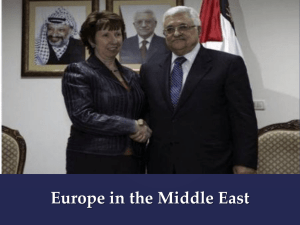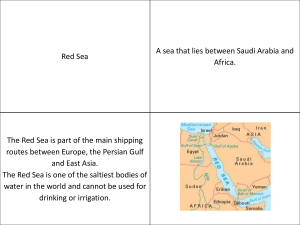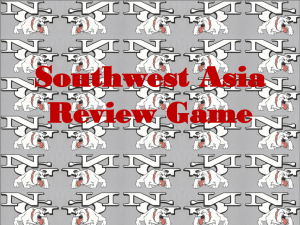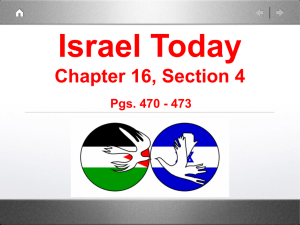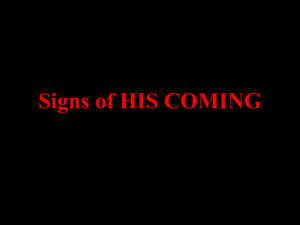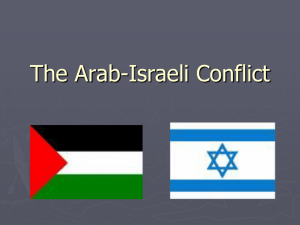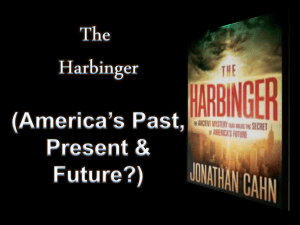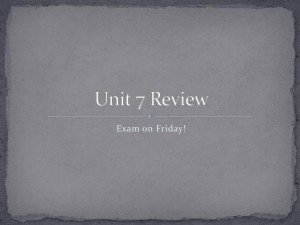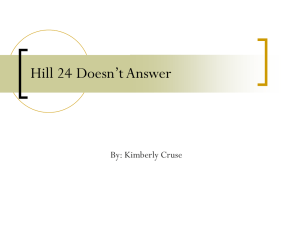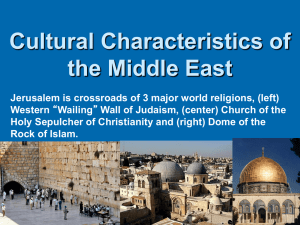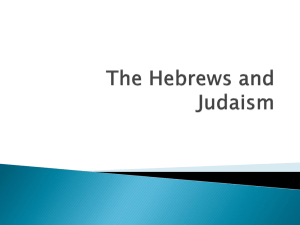Middle East
advertisement
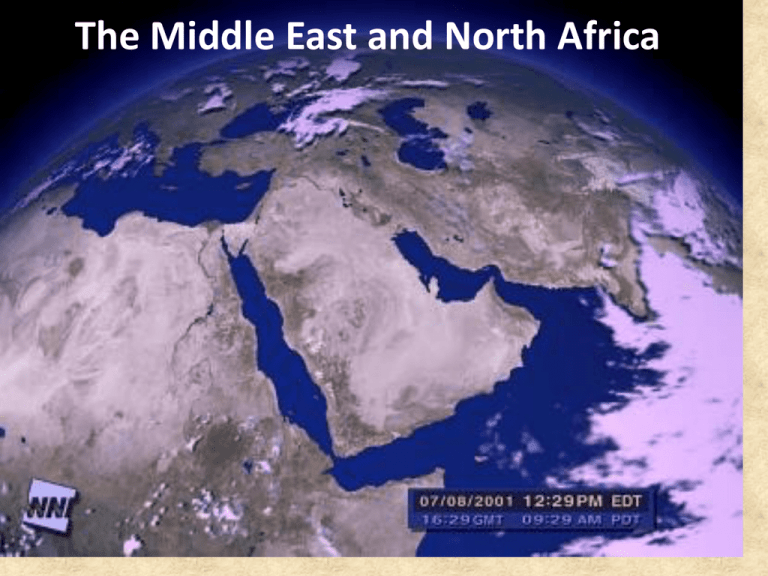
The Middle East and North Africa 1) Location Where is the Middle East? The Middle East is at the crossroads of three Continents: 1. Asia 2. Africa 3. Europe What is the Middle East Region? • Areas west of Afghanistan/Pakistan including Iran • Countries in Northern Africa along Mediterranean Sea • Turkey Why is Northern Africa included in the region? • Islam and Arabs– same religion, similar cultures Major Physical Features • Sahara Desert • Arabian Peninsula • Jordan River • Tigris River • Euphrates River • Nile River • Red Sea • Persian Gulf • Suez Canal • Strait of Hormuz 2) Human Environment Interaction Physical Geography - Middle East: Climate Regions What climate type dominates the region? What climate type is found around water? Physical Geography - The Middle East: Natural Vegetation What is the dominant vegetation zone in the region? Why is there a different vegetation zone through central Egypt? What resources are in the Middle East? • • • • • • Fresh Water Limited supplies in most countries Desalination plants – remove salt from water Dams - hydroelectricity Irrigation - for farming Petroleum/Oil Most countries either have oil or make money from it (refining it or pipeline fees) ½ of world supply of petroleum is in Middle East How does this affect you? Physical Geog - The Natural Resources of the Middle East What is the dominant form of agriculture in the Middle East? What mineral resource is most common in the Middle East? Where are there Fresh Groundwater Sources? What is Oil? Why is it Important? Produced from microscopic marine plants and animals, squeezed underground for millions of years. Oil is a “finite resource” • Once it is used up, it is gone forever. • Nobody is certain how much is left. Oil is used for many things: 1. Fuel, (gasoline, jet fuel, heating oil) 2. All plastic is made from petroleum 3. Asphalt used in road construction 4. Synthetic rubber in tires 5. Fertilizer, pesticides, and herbicides 6. Detergents, many drugs, and paints 7. Artificial fibers used in clothing (Nylon, Polyester) Global Oil Production What is OPEC ? • OPEC - “Organization of the Petroleum Exporting Countries” • Controls the price, production and distribution of oil. • 66% of world reserves of oil, 40% of world oil production What are our alternative energy sources? • • • • • • Solar Wind Hydrogen Nuclear Vegetable oil Grain alcohol – Gasohol/Ethonal • Hydroelectric • Ocean Currents • Geo-Thermal 3) Movement • Demographics, Immigration, Trade Routes, and Choke Points Demographics and Immigration • In general, the MENA has fast growing, very young populations. 50% under the age of 35 in most places. • Despite this, many countries buck this trend, with rapidly decreasing fertility rates. • The MENA is a primary source of immigrants to Europe and the West, mostly for economic reasons. • Some countries in the Persian Gulf, on the other hand, have large populations of immigrant workers from South and Southeast Asia for the same reasons. Trade Routes and Choke Points Suez Canal • Primary trade route connecting Europe and Asia • Built in Egypt by the French in the 1850’s and 1860’s. Straits of Hormuz • The Persian Gulf is a vital part of the world oil supply. • It is in a very dangerous part of the world. • It can easily be closed off by hostile countries. 4) Place History of the Middle East “Fertile Crescent” of river valleys, was cradle of civilization, around 4000 BC. • • • • Nile River Jordan River Tigris River Euphrates River Mesopotamia - Area of earliest towns, agriculture between Tigris and Euphrates Rivers Empires - Many different empires ruled this region: • • • • • • • Assyrians Persians Alexander the Great Romans Caliphate Sassanians European Islam – Dominated the region almost immediately after it appeared around 650AD, both religiously and politically. Middle East: Population Density Why is the population density so high in central Egypt? What other areas are most populated in the region? Why? Cultures of the Middle East • Majority speak Arabic (also Turkish, Farsi, Hebrew) • Many different ethnic groups, such as Arabs, Persians, Turks, Kurds • 90% follow Islam (Sunni and Shi’a) Many Ethnic Groups in the Middle East Middle Eastern Countries • Related history, similar issues and challenges • Religious conflicts, social turmoil • Limited natural resources (especially water) • Arid climate – hot and dry (136* in the shade in Libya!) • All countries border the ocean (except Afghanistan which is landlocked) Islam and the Middle East What three major religions began in Middle East? • Judaism, Christianity, Islam • Called “Religions of the Book”, or “Abrahamic Religions”, all related traditions. • Major events of Old Testament, New Testament, and Quran all happened in Middle East and North Africa. • Islam is now the dominant religion of the region, and has been since around 700AD. What is Islam? Primary religion of the modern Middle East, about 1.5 billion followers. Main idea: “There is no God but Allah, and Mohammed is his Prophet.” • Who – Muhammad • When – circa 610AD • Where – Arabian Peninsula • Holy Books – Quran (main text) and the Hadith (commentaries) Major Concepts of Islam • Islam means “submission to the will of God”. • Quran is considered the literal word of Allah, given to Mohammed by the Archangel Gabriel. • Sharia is Islamic law, covering nearly all aspects of life. Used by many Islamic countries as basis for their own legal codes. • Mosques are where Muslims gather to worship. • Five Pillars of Islam are the things one must do to be a practicing Muslim. • Jihad is “struggle”, whether internally for selfcontrol or externally for holy war. “Five Pillars” of Islam: 1. Statement of Faith 2. Prayer five times daily 3. Fasting during holiday of Ramadan 4. Alms to the poor 5. Visit holy city of Mecca at least once. أشهد أن ال إله إال هللا أشهد أن محـمداً رسـول هللا I declare that there is no deity except Allah. I declare that Muhammad is the Messenger of Allah. Difference between Sunni vs. Shia? • Two major sects of Islam. In modern times, Islam is split – about 85% Sunni, 15% Shi’a. • Differences started long ago, due to a dispute about who would lead the Muslim world (Umma) after Muhammad died. • Over time, the groups developed different beliefs and practices. It is a little like the differences between Catholics and Protestants. • Many modern conflicts in the Middle East have these differences at their root. This is called “sectarian violence”. “Kaaba” in Mecca, site of pilgrimage. Why are women covered up? • • • Islam encourages modest dress. Different cultures interpret this differently, and require different things from women. Some women see it as subjugation, some see it as proper. Not all countries follow the same customs, nor do all women in a country follow the same customs. Some places it is a choice, others it is the law. In a few places, it is enforced with violence against women. Head covering is called Hijab. Only the eyes exposed is called Niqab. Head to toe is called Burka. 5 ) Region • Issues, Crisis, and Conflicts • There is a lot of stuff covered in this presentation, so strap in. CONFLICT: Iran, Iraq, and the Persian Gulf Iraq and Iran – NOT THE SAME IRAQ IRAN ETHNIC GROUP ARABS PERSIANS LANGUAGE ARABIC FARSI ISLAMIC SECT 20% SUNNI, 80% SHI’A 90% SHI’A GOVERNMENT DEMOCRATIC REPUBLIC ISLAMIC THEOCRACY BAGHDAD TEHERAN WEST EAST FRIENDLY OPPOSED CAPITAL LOCATION RELATION TO USA USA in the Persian Gulf Why are we there? • To protect the flow of oil to the world, mostly. We need it, and that is where it comes from. There are other reasons, but this is probably the most significant. What have we done there? • The USA has supported dictators, overthrown governments, sold weapons to both sides in a war, and fought wars. What resulted from this? • USA is mistrusted in the region, involved in a long war, and facing terrorism at home. What it worth it? • Maybe. Gotta have the oil, after all. Why is there conflict with Iran? • 1950’s-1970’s, USA supported the “Shah” (Emperor) of Iran because he was antiCommunist. He was a harsh ruler. • In 1979 an Islamic Revolution happened, led by Ayatollah Khomeini, opposed to the USA. They took 50+ American hostages, held them for almost a year and a half. • Iran has opposed the USA on Israel, Iraq, and nuclear weapons. The Iranian government calls the USA the “Great Satan”. • Iran was once Persia, a great empire, and it wishes to resume importance on the world stage. • They are currently threatening to close the Strait of Hormuz/Persian Gulf, due to international sanctions against them. What are the Gulf Wars? Conflicts between the USA, Iraq, and Iran to control the Persian Gulf. Alliances shift – today’s ally is tomorrow’s enemy! 1. IRAN-IRAQ WAR (1980-1988): Iran vs. Iraq; Chemical weapons used by both sides, possibly a million people died. US supported Iraq and Saddam Hussein, but covertly sold weapons to Iran. 2. GULF WAR (1991): US vs. Iraq; Saddam Hussein invaded Kuwait to take the oilfields. USA and coalition fought to protect Saudi and Kuwaiti oilfields. War stopped by UN with Saddam Hussein still in power. 3. IRAQ WAR (2003-2011): US vs. Iraq; USA and allies invaded Iraq to remove Saddam Hussein. Sectarian fighting between Shia vs. Sunni vs. Kurds. US withdrew in 2011. Kurds and Kurdistan • The Kurds are a people who live in the Middle East, about 30,000,000 in all. They have their own language and culture, and a separate identity as Kurdish people. • They have no country of their own, instead living scattered across a dozen other countries, including Turkey, Iraq, and Iran. • They are in conflict with several governments, as some wish to create a separate Kurdish country, called Kurdistan. • Kurds often point to the Jews and the creation of Israel as an example. The Arab Spring The “Arab Spring” Revolts The Arab Spring is a wave of demonstrations and protests occurring in the Arab world starting in late 2010. • Revolutions in Tunisia and Egypt • Civil war in Libya resulted in fall of its government • Civil uprisings in Bahrain, Syria, and Yemen, resulting in resignation of Yemeni prime minister • Major protests in Algeria, Iraq, Jordan, Kuwait, Morocco, and Oman • Minor protests in Lebanon, Mauritania, Saudi Arabia, Sudan, and Western Sahara. • Clashes between Israel and Palestine along border posts also inspired by Arab Spring. Arab Spring Revolts The protests have shared techniques of civil resistance, as well as the use of social media (Facebook and Twitter) to organize and coordinate. Many demonstrations have met violent responses from authorities, as well as from pro-government militias and counter-demonstrators. Improvised riot helmets in Tahrir Square (Egypt)!!! Results of the Arab Spring As of January, 2013, the following changes have resulted from the Arab Spring: Crisis in Syria • Syria is a small country located between Iraq and Turkey, with a powerful military. Before the Arab Spring, Syria was ruled by the Assad family as a dictatorship. • In 2011, demonstrations against the Assad turned violent. By 2012, a full civil war was on between the Assad government and rebel factions, including some Islamists and some supported by Iran… not friends of the USA. • The USA supports some of the rebels in theory, but many of them consider us enemies. Russia and China support the Assad regime. • To make matters more complicated, the Syrian military has a lot of chemical weapons, very dangerous. Someone used chemical weapons in August, 2013; evidence points to Assad, though this is still in dispute. CONFLICT: Israel and the Arab World Places to Know • • Israel – Jewish state, founded in 1948. “Occupied Territories” West Bank – Palestinian area between Jerusalem and Jordan River, run by FATAH. • Gaza Strip – Palestinian area on Mediterranean coast, run by HAMAS. • Golan Heights – Syrian territory, occupied by Israel for military reasons in 1967. • Sinai Peninsula – Part of Egypt, captured by Israel in 1967, given back to Egypt in 1979 as part of peace agreement. Creation of Israel • Zionism- Political movement for a Jewish homeland. Jews to return to “Promised Land”. • Organized by Theodore Herzl in 1897. • Why? Jews faced persecution and genocide throughout their history. Worldwide sympathy for Jews after WW2. • Jews started moving to Palestinian region in 1890’s – 1930’s. • Conflict with local Arabs over land, water, business. How was modern Israel created? United Nations settled on Palestine for a Jewish Homeland • Why Palestine? 1. Ancient kingdom of Israel, “Promised Land” 2. Not very crowded in the 1940’s 3. Controlled by Britain, which was willing to give it to Jews 4. Political movement by Zionists, already settling there 1948 – UN Resolution 181 divided Palestine into 3 sections: 1. Israel – for Jews 2. Palestine – for Arabs 3. Jerusalem – run by UN for all groups Immediately triggered the 1948 war, first of many Arab-Israeli wars. Arab-Israeli Wars • Israel believes it has a right to exist. • Arab nations feel that Israel was forced upon them by the West. • Both sides became part of the “Cold War”, aggravating the issue. Arabs and Israelis fought several large wars and many small ones. The three most important ones are: • 1948 – “War of Independence”/Nakba: Arab armies invaded, Arab refugees fled, hoping to return after war. Israel won. These refugees became today’s Palestinians. • 1967 – Six Day War: Egypt, Syria prepped for war, but Israel hit first. Total win for Israel, occupied lots of territory, including West Bank, Gaza, and Golan Heights, and captured Jerusalem. • 1973 – Yom Kippur War: Arab militaries struck Israel during holiday, when Israeli military was on leave. Close call for Israel, which relied heavily on US support. Israel won. • Major wars ended after Camp David Agreements (1977-1978), peace between Egypt and Israel, later Jordan. Other Arab countries still officially hostile, but no large wars since. Israel vs. Palestinians • In the 1948 war, many Arabs left their homes, living in refugee camps in the West Bank and Gaza. After 1967 War, Israel expanded into this captured land, and occupied it directly. • Most Palestinians live in West Bank and Gaza, area which are crowded and poor. Formed the “Palestine Liberation Organization (PLO)” to fight Israel. • Peace negotiations have gone on since 1990, but several uprisings, called “Intifadah” have occurred. • Two main groups against Israel: – Fatah – Once part of PLO, controls the West Bank, backed by Arab countries. – Hamas – Controls Gaza, backed by Iran. Jerusalem Jerusalem is a holy city for Jews, Christians, and Muslims. It has been fought over for thousands of years. • In the 1967 “Six Day War”, Israel captured the entire city, and made it the capital of Israel. Part had previously been controlled by Jordan. • The Palestinians see it as part of the West Bank, and thus belonging to them. • The “Western Wall”, part of the ruins of the main temple of Judaism, is considered the holiest site by Jews. • The “Dome of the Rock” is a mosque where Muslims believe Muhammad ascended into heaven. • Both sites are on the same hill, with constant tensions between Jews and Muslims. Occupied Territories • The Palestinian controlled territories of West Bank and Gaza are both crowded and poor. • Travel and business are difficult due to the large number of security barriers and checkpoints put into place by Israel. • Occupied territories are further divided up by Israeli settlements and roads only usable by Israelis, especially the West Bank. • This builds resentment and leads to frequent violence between Israel and Palestinian militant groups, especially Hamas.

